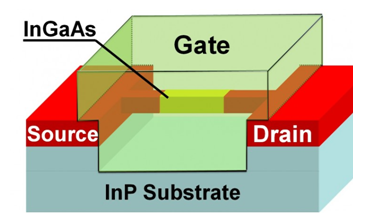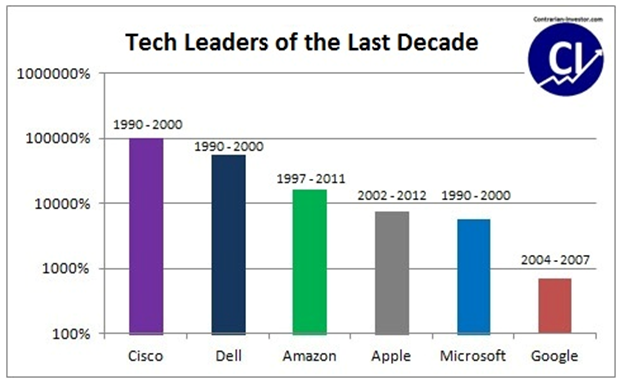Part of being a successful contrarian investor is being able to watch trends, see how the world is changing and adapt to it. The small changes of today will grow into large shifts tomorrow. In the world of technology the new breakthroughs of today will serve as building blocks for advancements in the future. Of course, no one knows exactly what the future entails, but by watching the emergence of trends you can anticipate how the world will shape up in one, two, five or even ten years.
The only thing that is guaranteed in life, other than death and taxes, is change. Some people are afraid of change and stubbornly cling on to the “old way of things”, but the successful forward looking investors and visionaries embrace change and benefit from it. By adopting to change and adjusting your strategies you are likely to find opportunities early, before most others.
Technology is not only changing and becoming more advanced but the rate of the change is also growing faster and faster. According to the inventor and futurist Ray Kurzwiel, the advancement of technology is growing exponentially. You can see this exponential growth in the semiconductor industry. In 1965 Gordon E. Moore predicted that the number of transistors that can be placed inexpensively on an integrated circuit would double about every 18 months. And despite many critics and naysayer the rate of growth in computing power has only increased over the past decades; now doubling every 12-14 months.
Despite all these advancements it may not feel like technology is growing exponentially. Sure, new computer models are being released every year. But where are the new revolutionary technologies? Part of the reason we may not feel this rapid growth is because not much happens from day to day, and we only gradually take steps towards new advancements. And once a new technology has emerged we quickly take it for granted and we feel that it has been around all along.
But radical changes are taking place and you may appreciate these changes by looking at the progress made over the last five, ten, and twenty years. For example, if someone would have told you 20 years ago that there would be a virtual network connecting everyone on the globe, or that people would carry pocket size device (smart phones) that with a press of a button can access virtually any information ever thought about, people would probably think you were dreaming.
The chart below shows the rapid growth in technology. Just during the last 100 years the progress in technology has exploded, and we should expect this growth to continue. The internet has made the distribution of information available to virtually anyone; fostering an environment for collaboration and sharing of ideas. In addition, there are currently more engineers and scientists in the field today than all the accumulated engineers and scientists throughout history. The combination of these two variables will lead to greater growth in the field of science with evermore discoveries.
Emerging trends
We may be closer to new scientific breakthroughs than most people realize. In a not so distant future; innovations currently in infant stages, in computer technology and biotechnology will emerge and change the world beyond recognition. The building blocks are already in place and I can see these trends emerging over the years and decades to come.
Miniaturization of computers
Computers are becoming smaller and smaller. They have gone from gigantic mainframe computers the size of a house in the 1960s, only available in universities and government laboratories, to desktop computers, laptops, and now smart phones. At the current rate of change, computers will soon be small enough to fit inside your clothing.
Moore’s law is still alive and well and the rate of growth is only increasing in speed; now doubling almost every year. Just last year, a technology revolution occurred, with the advent of the Tri-Gate transistor, and almost nobody outside the high-tech world noticed. In May, Intel displayed what they call the Tri-Gate transistor; a three-dimensional transistor in which electrons flow not just in a flat channel but along three sides of a raised fin. What’s significant about this chip is not only its improved computing performance, but it will be smaller and only use half the power of a regular chip; thereby generating less heat. All this means faster, lighter, cooler computers. The chip is scheduled to enter the market sometimes in 2012.
As computers continue to shrink in size so will the interface used to interact with them. Rather than using a traditional mouse and keyboard to input data, new technologies are being developed to input data by following the user’s eye movements or reading the retina of the eyes.
Google, for example is already working on glasses with heads-up display that has the ability to connect to a wireless network. It has been rumored by Google employees that the device will connect to your smart phone and provide real time information on a user's location via GPS and motion sensors. It will tap into Google's cloud and relay information to the user on their environment, including locations or friends nearby and objects that they look at, allowing users to make calls, use certain apps, and connect with friends.
Actually controlling the glasses will be a bit unique, as reading through information on the display will require a user to tilt their head to scroll and click. Sources at Google have noted that this function is actually a lot easier to use than it sounds, and will not be noticeable to others.
Meanwhile, Lumus limited is another company that is also developing a new line of video glasses that the user can see through. The transparent lenses display to the eye what looks like a 87-inch screen, while allowing you to see what's going on in front of you at the same time.
The video quality is currently at 720p, with a 1080p version in development. The glasses can display content from devices like an iPhone through the use of a special adapter. Besides watching movies, the idea is that the glasses could be used for things like presentations, where you want to read a speech while focusing on your audience or for directions to a location while you're walking around.
Biotechnology
Not just improvements in computer technology and electronics are driving change today, but rapid advances are being made in biotechnology and biomedicine. For example, scientists at MIT developed a double-stranded RNA activated caspase oligomerizer (DRACO) last year that can fight viruses as effectively as antibiotics fight bacteria. In lab tests, it was effective against 15 viruses, including the rhinovirus, which causes colds; H1N1 influenza; dengue fever; and poliovirus.
Other progress on the horizon is in made in nanomedicine, which is basically the application of nanotechnology to medicine like diagnosis and treatment of disease. There are several applications within the realm of nanotechnology that are making headway.
These applications include diagnostics, sensors and surgical tools used outside the patient, imaging agents and monitoring technologies that can be used for diagnostic and sensing on a cellular level inside of the patient, and finally biomaterials used for drug delivery and tissue engineering to promote tissue repair.
Nanotechnology and Nanomedicines is still in an infant stage with first generation technologies like liposomes and PEGylated used for delivering pharmaceutical drugs and nutritional supplements. But more sophisticated nanotechnology is in development.
For example, advancements are being made in cancer treatment. One promising new technique, currently in a development stage, involves delivering a drug made up of small packages of nanoparticles to a tumor. Then once the packages are surrounding the cancerous cells, ultrasound would be directed at the target, breaking the packages, releasing the drug and killing the tumor. Other unrelated lines of research include using antibodies to deliver gold or other metallic nanoparticles to a cancer cell. Then radio waves would be used to heat up the metal and burn the cells in the tumor.
We may still be far away from the ultimate goal of having live nanobots (live molecular size robot) in our bodies able to travel to problem cells and repair them on the fly without any other type of intervention or medical procedures. Nonetheless, advancement in this area has already been made. Researchers at Harvard have made an organic type of nanobot from DNA with the ability to seek out specific cells and give a set of molecular instruction; like telling cancer cells to kill themselves.
Many of the cutting edge companies in the field of nanomedicine are still privately held, backed by venture capital. But a day will come when these companies go public. In the meantime, a public company to watch is Arrowhead Research Corporation (ARWR), a nanomedicine company developing leading drug-delivery systems.
Commercialization of 3D Printing
A revolution in manufacturing is under way. It is in its infant stages, but it will likely reach epic proportions in this coming decade. This technology will turn the economics of manufacturing upside down and change the way products are made, marketed and sold.
Despite relatively unknown, this industry is already a $1 billion business. And the stage is set for massive growth in the years to come. Manufacturers of 3D printers like 3D Systems (DDD) and Stratasys (SSYS) are both generating more than $140 million per years in revenue, and growing rapidly.
Prominent clothing designers, aerospace companies, automotive manufacturers, and consumer electronics companies are already using 3D additive manufacturing to quickly produce prototypes. 3D printing allows them to quickly and inexpensively go from the drawing board to tangible model or prototypes. Many of the products you have at home today have been designed and prototyped with the help of a 3D printer, but we haven’t seen anything yet.
What exactly is 3D printing?
It is simply the process of putting together a three dimensional object, layer by layer, as opposed to the traditional practice of subtractive manufacturing where multiple subcomponents make a final product. The advantage of 3D additive manufacturing is that one machine, the 3D printer, builds the part from start to finish without the need for any additional processes, treatments, or special handling.
3D printing always starts with the design of three-dimensional CAD (computer-aided design) that is sliced into thin layers, and then fed to the 3D printer. The printer then typically employs one of six manufacturing technologies to create the desired object.
This technology will really take off when the cost of these devices come down, making manufacturing affordable to virtually anyone. Sometime in the future lies the vision that we can instantly download, distribute, and manufacture anything, anytime, and anywhere. We may well be a decade away from this technology becoming mature, but once here it will revolutionize the way of commerce, just like the internet did in the 1990’s.
Investment Implications
How does these emerging technologies relate to investing? These technologies are still in their infant stages but at some point some emerging companies is going to deliver these products to the market at an affordable price point. And perhaps the next Microsoft or Apple has already been born. 
Huge returns will be made by those investors with the insight to find the next innovator of the future. The chart shows the returns of the technology leaders of the last decade.
- English (UK)
- English (India)
- English (Canada)
- English (Australia)
- English (South Africa)
- English (Philippines)
- English (Nigeria)
- Deutsch
- Español (España)
- Español (México)
- Français
- Italiano
- Nederlands
- Português (Portugal)
- Polski
- Português (Brasil)
- Русский
- Türkçe
- العربية
- Ελληνικά
- Svenska
- Suomi
- עברית
- 日本語
- 한국어
- 简体中文
- 繁體中文
- Bahasa Indonesia
- Bahasa Melayu
- ไทย
- Tiếng Việt
- हिंदी
For The Technology Investor; The Promise Of Accelerating Growth In Technology
Published 03/05/2012, 04:34 AM
Updated 07/09/2023, 06:31 AM
For The Technology Investor; The Promise Of Accelerating Growth In Technology
Latest comments
Loading next article…
Install Our App
Risk Disclosure: Trading in financial instruments and/or cryptocurrencies involves high risks including the risk of losing some, or all, of your investment amount, and may not be suitable for all investors. Prices of cryptocurrencies are extremely volatile and may be affected by external factors such as financial, regulatory or political events. Trading on margin increases the financial risks.
Before deciding to trade in financial instrument or cryptocurrencies you should be fully informed of the risks and costs associated with trading the financial markets, carefully consider your investment objectives, level of experience, and risk appetite, and seek professional advice where needed.
Fusion Media would like to remind you that the data contained in this website is not necessarily real-time nor accurate. The data and prices on the website are not necessarily provided by any market or exchange, but may be provided by market makers, and so prices may not be accurate and may differ from the actual price at any given market, meaning prices are indicative and not appropriate for trading purposes. Fusion Media and any provider of the data contained in this website will not accept liability for any loss or damage as a result of your trading, or your reliance on the information contained within this website.
It is prohibited to use, store, reproduce, display, modify, transmit or distribute the data contained in this website without the explicit prior written permission of Fusion Media and/or the data provider. All intellectual property rights are reserved by the providers and/or the exchange providing the data contained in this website.
Fusion Media may be compensated by the advertisers that appear on the website, based on your interaction with the advertisements or advertisers.
Before deciding to trade in financial instrument or cryptocurrencies you should be fully informed of the risks and costs associated with trading the financial markets, carefully consider your investment objectives, level of experience, and risk appetite, and seek professional advice where needed.
Fusion Media would like to remind you that the data contained in this website is not necessarily real-time nor accurate. The data and prices on the website are not necessarily provided by any market or exchange, but may be provided by market makers, and so prices may not be accurate and may differ from the actual price at any given market, meaning prices are indicative and not appropriate for trading purposes. Fusion Media and any provider of the data contained in this website will not accept liability for any loss or damage as a result of your trading, or your reliance on the information contained within this website.
It is prohibited to use, store, reproduce, display, modify, transmit or distribute the data contained in this website without the explicit prior written permission of Fusion Media and/or the data provider. All intellectual property rights are reserved by the providers and/or the exchange providing the data contained in this website.
Fusion Media may be compensated by the advertisers that appear on the website, based on your interaction with the advertisements or advertisers.
© 2007-2024 - Fusion Media Limited. All Rights Reserved.
